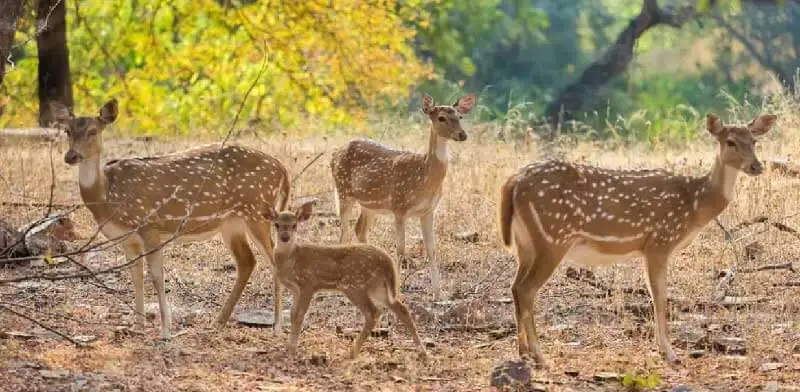
Ranthambore National Park, located in the Sawai Madhopur district of Rajasthan, India, is known for its rich biodiversity. The park is a mix of deciduous forests, open grassy meadows, lakes and ancient ruins, providing a diverse habitat for a wide range of flora and fauna. Here's an overview of the flora and fauna found in Ranthambore:
Flora in Ranthambore:
The peacefulness and enthralling natural environs of Ranthambore Forest are incredibly calming and a mental treat. This land is a remarkable sight for nature enthusiasts because of the contrast between the scanty vegetation in the desert part and the thick green area. Nearly 300 different types of vegetation are thought to exist in and around the Ranthambore Reserve Forest. The majority of the vegetation in the vicinity of the Thar Desert is dry deciduous because there is very little rainfall in this area.
Dhok (Anogeissus Pendula): Dhok is a predominant tree species in Ranthambore, forming a major portion of the park's dry deciduous forests.
Babul (Acacia Nilotica): Babul trees are common in the park and provide important fodder for herbivores.
Kadam (Mitragyna Parvifolia): The Kadam tree is found near water bodies and adds to the overall diversity of the forest.
Jamun (Syzygium Cumini): Jamun trees, also known as Indian blackberry or Java plum, are found in the park and bear fruit, attracting various bird species.
Banyan (Ficus Benghalensis): The iconic Banyan trees with their expansive canopies are scattered throughout the park.
Pipal (Ficus Religiosa): Another species of fig, the Pipal tree, is also present in Ranthambore.
Fauna in Ranthambore:
The Ranthambore forest is home to the magnificent tiger, the apex predator in the food chain. While known to be nocturnal and solitary, tigers in this park are diurnal, making it popular for day visits. Other big cats include leopards and desert cats, along with sloth bears, jackals and antelopes.
Bengal Tiger (Panthera Tigris Tigris): Ranthambore is famous for its Bengal tigers, and the park is considered one of the best places to spot these majestic big cats in the wild.
Leopard (Panthera Pardus): Leopards are also found in Ranthambore, though they are more elusive than tigers.
Ranthambore Reserve ForestThe park is home to sloth bears and sightings are possible, especially around water sources.
Indian Wild Boar (Sus Scrofa): Wild boars are common in Ranthambore and are often spotted foraging in the grasslands.
Sambar Deer (Rusa Unicolor): The largest deer species in India, the sambar deer, is abundant in Ranthambore.
Chital (Axis Axis): Also known as spotted deer, the chital is another common herbivore found in the park.
Nilgai (Boselaphus Tragocamelus): The blue bull, or nilgai, is the largest antelope species in Asia and is often seen in the open grassy areas.
Indian Gazelle (Gazella Bennettii): The chinkara, a species of Indian gazelle, can be found in the arid regions of the park.
Crocodile: Ranthambore has several water bodies, and Mugger crocodiles can be spotted in these lakes and rivers.
Various Bird Species: Ranthambore is a paradise for bird enthusiasts. Commonly seen birds include peafowl, Indian grey hornbill, crested serpent eagle, painted stork, and many others.
The park's ecosystems support a delicate balance between predators and prey, making it a fascinating destination for wildlife enthusiasts and conservationists. Visitors can explore the park through safari experiences in Ranthambore, which are available in different zones, each with its unique landscape and wildlife viewing opportunities.